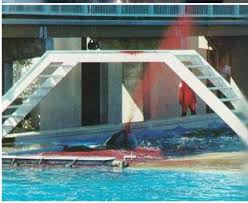SeaWorld San Antonio has confirmed the death of Kamea, an 11-year-old female orca and the youngest member of the park’s captive pod. Born in captivity in 2013 to matriarch Takara, Kamea died on June 19 after a sudden illness. The park has not disclosed the cause of death—likely to avoid backlash—as her passing brings the number of orcas who have died at SeaWorld parks to 45, reigniting fierce criticism of the conditions and ethical implications of keeping these apex predators in captivity.
While SeaWorld cited “round-the-clock veterinary care,” critics point to the hidden toll behind such statements: a daily regimen of pharmaceuticals designed not only to treat illness but to chemically suppress the psychological effects of confinement. Captive orcas, deprived of the vast range, complexity, and social dynamics of ocean life, are frequently administered antibiotics, anti-fungals, sedatives, antacids, painkillers, and even psychotropic drugs they also often have their teeth drilled because they suffer from tooth damage and infections particularly in the lower jaw caused by unnatural behaviours that arise due to stress, boredom, and frustration.
Worryingly, long-term antibiotic use—often employed prophylactically in tank environments—has left many if not all captive orcas resistant to common bacterial strains. As a result, when genuine infections arise, standard treatments often fail, leading to prolonged illness, suffering, and death.
“According to marine mammal health experts, this isn’t just about stress. It’s about bodies being broken down over years, immune systems being overwhelmed, and the very tools meant to help them becoming ineffective. Antibiotic resistance has become a quiet crisis in captive orca care.”
Orcas in the wild swim over 40 miles a day and can dive to depths of up to 500 feet. They are among the most intelligent species in the animal kingdom, with highly complex social structures and strong familial bonds—much like those of humans. Orcas give pod members unique names through distinct whistles and clicks, mourn their dead, and even pass down cultural traditions. However, they do not find amusement in keeping other species captive for profit—raising the question of how empathetic and intelligent they are compared to humankind.
Kamea’s death follows a troubling pattern: young orcas many born into captivity succumbing to complex illnesses rarely observed in wild populations. In the wild, female orcas commonly live between 50 and 80 years, with some reaching over 90. Males typically live shorter lives, averaging around 30 years but sometimes reaching 60.
In stark contrast, orcas in SeaWorld’s care rarely live beyond their teens or early twenties, with many dying well before reaching what would be considered middle age in the wild.

Animal rights organisation PETA responded swiftly, calling Kamea’s death “predictable and heartbreaking.” The group has called for the remaining orcas to be moved to seaside sanctuaries and for SeaWorld to scatter Kamea’s ashes at sea—“in the freedom she was never given in life.”
Kamea’s short life was defined by confinement, medical intervention, and the slow erosion of natural behaviours. For many, her death is not an isolated incident—it is the latest indictment of a system that many believe can no longer justify itself.
“No amount of medication or public relations can undo what captivity does,” said Orca expert Dr. Ingrid Visser. “We are watching the consequences of an outdated model unfold in real time.”
SeaWorld has not released details of Kamea’s necropsy and has made no announcements about memorials or changes to its animal care policies.
Despite ending its captive breeding program in 2016, SeaWorld continues to hold orcas prisoners in their San Diego, San Antonio, and Orlando parks. Public pressure to phase out live marine mammal exhibits has grown significantly in recent years, spurred by scientific consensus and cultural shifts following the release of the documentary Blackfish. However, SeaWorld will continue to keep these animals captive as long as the public continues to support it financially.
If you wish to see orcas, please do not support places like SeaWorld or Loro Parque. In Spain, we are fortunate to have wild orcas living along our own coastline. They can be seen during the summer months off the coast of Tarifa, Cádiz—free-ranging, social, and hunting as nature intended.
For those interested in witnessing these magnificent creatures responsibly, Turmares, located in Tarifa, Cádiz, is one of the most reputable companies offering ethical, science-informed whale watching tours. You can visit their website at www.turmares.com for more information.
It is vital to ensure that only responsible whale watching is practiced, supporting operators who follow strict guidelines to avoid disturbing the animals and their habitat.
For anyone wanting to learn more about the abuse and ethical concerns within the captive whale and dolphin industry, the documentaries Blackfish and The Cove are essential viewing. They provide powerful, eye-opening accounts of the lives of captive orcas and dolphins, and the consequences of captivity. In Spain, both are available on platforms including Netflix and Amazon Prime Video.













